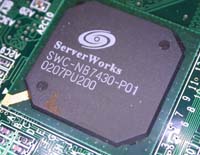Xeon 2.8GHz DP & 2.0GHz MP - Part I: Taking over the Enterprise
by Anand Lal Shimpi on November 18, 2002 9:04 AM EST- Posted in
- IT Computing
New Platforms - DDR Across the Board
A year ago, Intel's Xeon could only be paired with RDRAM on the 860 chipset; today, there isn't a single chipset being introduced with RDRAM support. This mirrors Intel's efforts on the desktop side, with Springdale on its way to replace the 850E as the high-end desktop platform of choice. As we've mentioned in the past, this doesn't mean Intel's abandoning RDRAM completely - but it does mean that the two are on a pretty big break. For now, RDRAM isn't necessary in the desktop, workstation or server segments; and the success or failure of DDR2 will determine whether it is in the near future.
From top to bottom Intel has finally regained their lost title as the king of chipsets. Today Intel has chipsets for virtually every market segment, with the exception of the 4-way+ configurations which are handled by ServerWorks.
On the entry-level workstation side Intel announced the official name for their Granite Bay chipset today - the E7205. We're covering the E7205 in a separate article today but it deserves a mention here because of its role as a workstation chipset. Despite Intel's attempts to make the 7205 a workstation board, most motherboard manufacturers will be producing high-end desktop solutions based on the chipset - designed to replace the 850E in their product lines.
The features of the E7205 are as follows:
- Single Processor Pentium 4 support
- 2 x 64-bit DDR266 memory channels (just like NVIDIA's nForce2)
- 533MHz FSB support
- AGP 8X support
- USB 2.0 support
What's worth noting is there is no DDR333 support provided by the chipset. Just as we saw with the nForce2, keeping the FSB and memory bus in sync with one another result in faster overall performance. Also, dual channel DDR333 won't be necessary until Intel increases the FSB once again to 667MHz, which will require a higher bandwidth memory bus. Chances are that we will see dual channel DDR333 support with the forthcoming Springdale chipset, or potentially a second revision of Springdale.
Next we have the E7505 chipset, otherwise known as Placer. The role of the 7505 is to basically take the functionality provided by the E7205 and bring it to dual processor Xeon workstations. The specifications of the chipset are the same, the only difference is that these chipsets are validated for dual processor operation and support the 604-pin Xeon DP interface.
Moving onto the server side, Intel is updating their current chipset line with the Plumas-533, now known as the E7501 chipset. The original Plumas chipset (E7500) was the first dual channel DDR solution from Intel and as the name implies, the E7501 simply adds support for the 533MHz FSB and dual channel DDR266.
Just like the E7500, the 7501 does not have an AGP interface (why would you need AGP on a server?) and is strictly a Xeon DP chipset, Pentium 4 owners will have to stick to the E7205 (Granite Bay).
For 4-way configurations Intel once again turns to ServerWorks to provide the chipsets for the Xeon MP. The upfront investment cost of developing a 4-way (or more) chipset is incredible, requiring tens of millions of dollars of development and validation. It should be noted that these costs are significantly reduced with a more simplified MP architecture such as AMD's Opteron, but with the conventional x86 MP setup they remain just as high. Because of the extremely high barrier to entry, ServerWorks finds themselves without competition in this arena and thus they service the entire 4-way Xeon server market.
ServerWorks' Xeon MP chipsets have been around for quite some time and thus there's nothing new to report on here. The Grand Champion HE is their top of the line solution offering support for up to 4 processors and up to 4 independent, load-balanced 64-bit memory controllers.

Since the Xeon MP processors still all connect to the North Bridge through a 3.2GB/s FSB link, having a 6.4GB/s memory bus might seem a bit useless. However, if you take into account that a great deal of these 4-way machines require more than 1GB/s of I/O alone, it is clear where the additional memory bandwidth becomes useful.










0 Comments
View All Comments